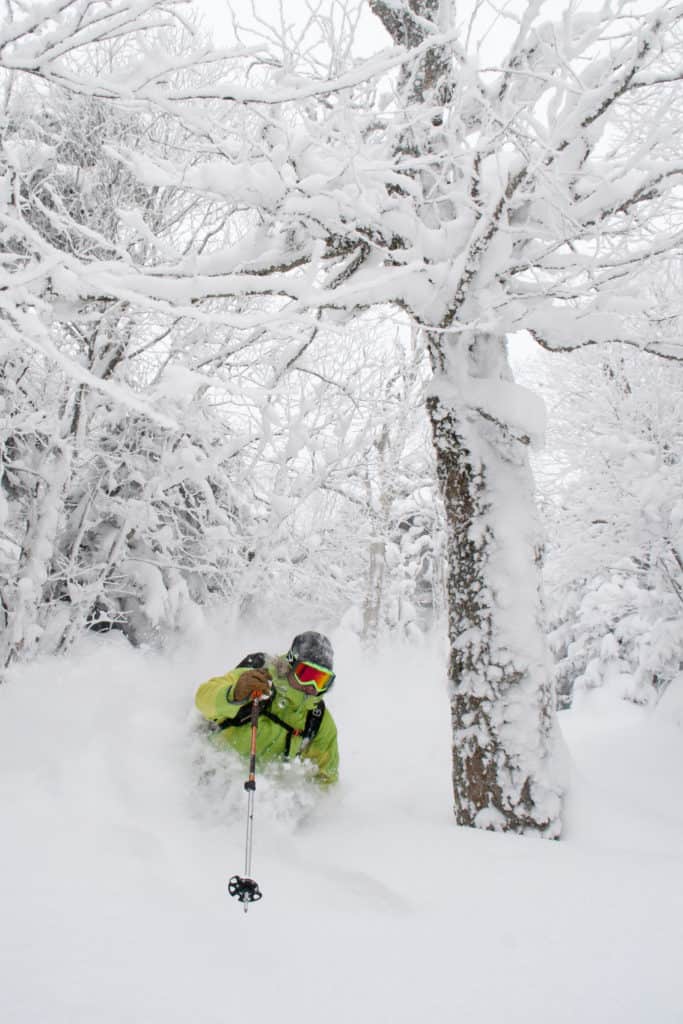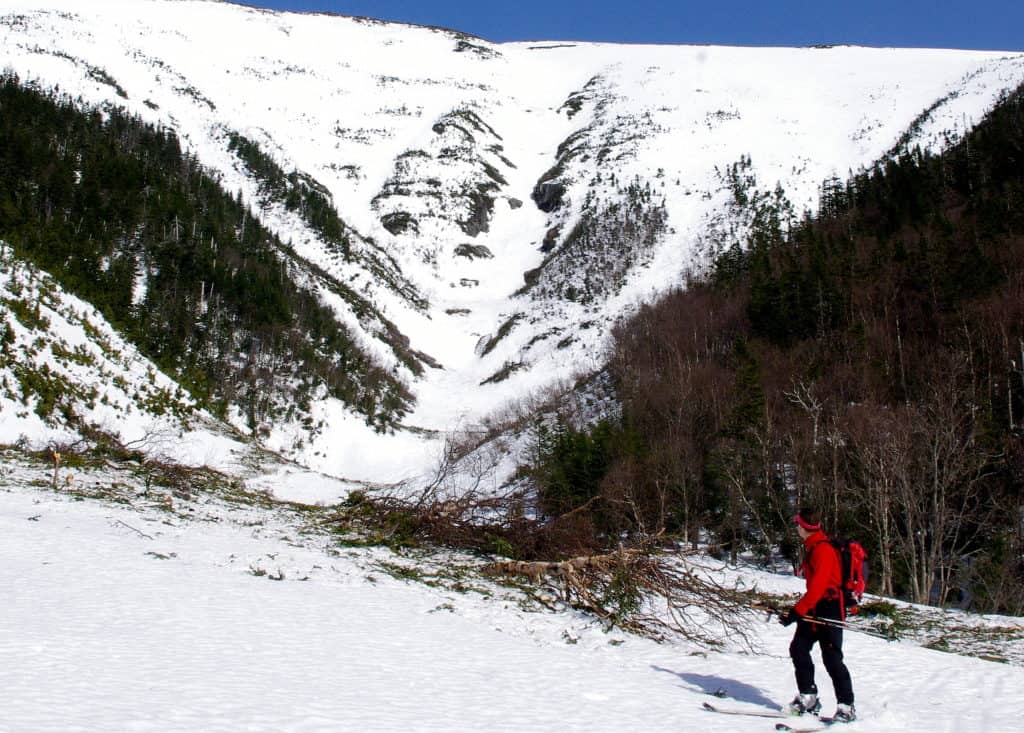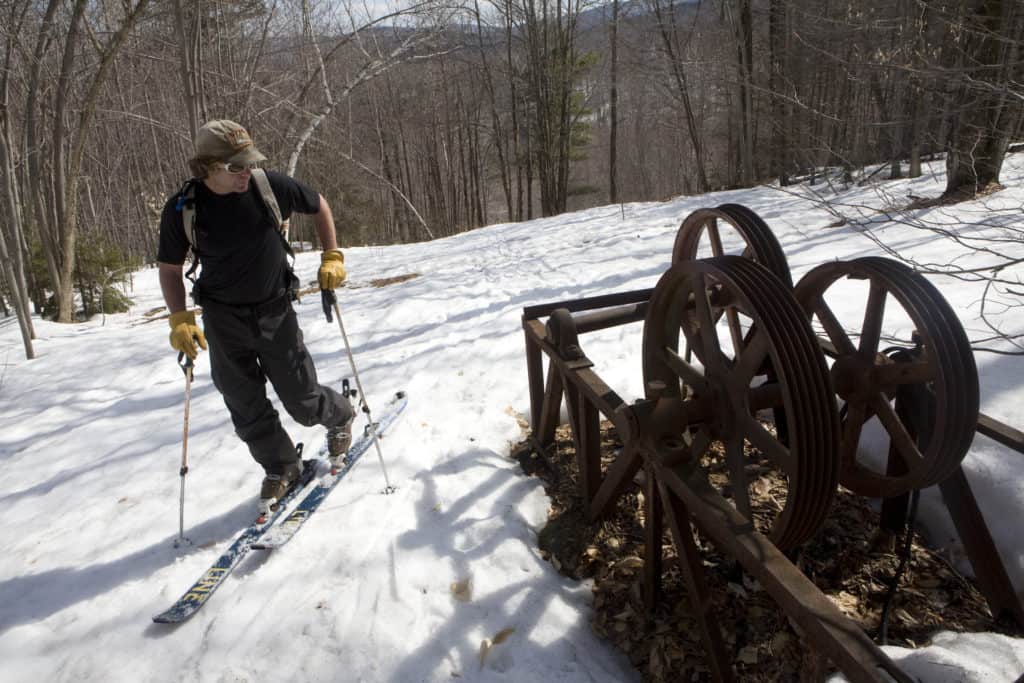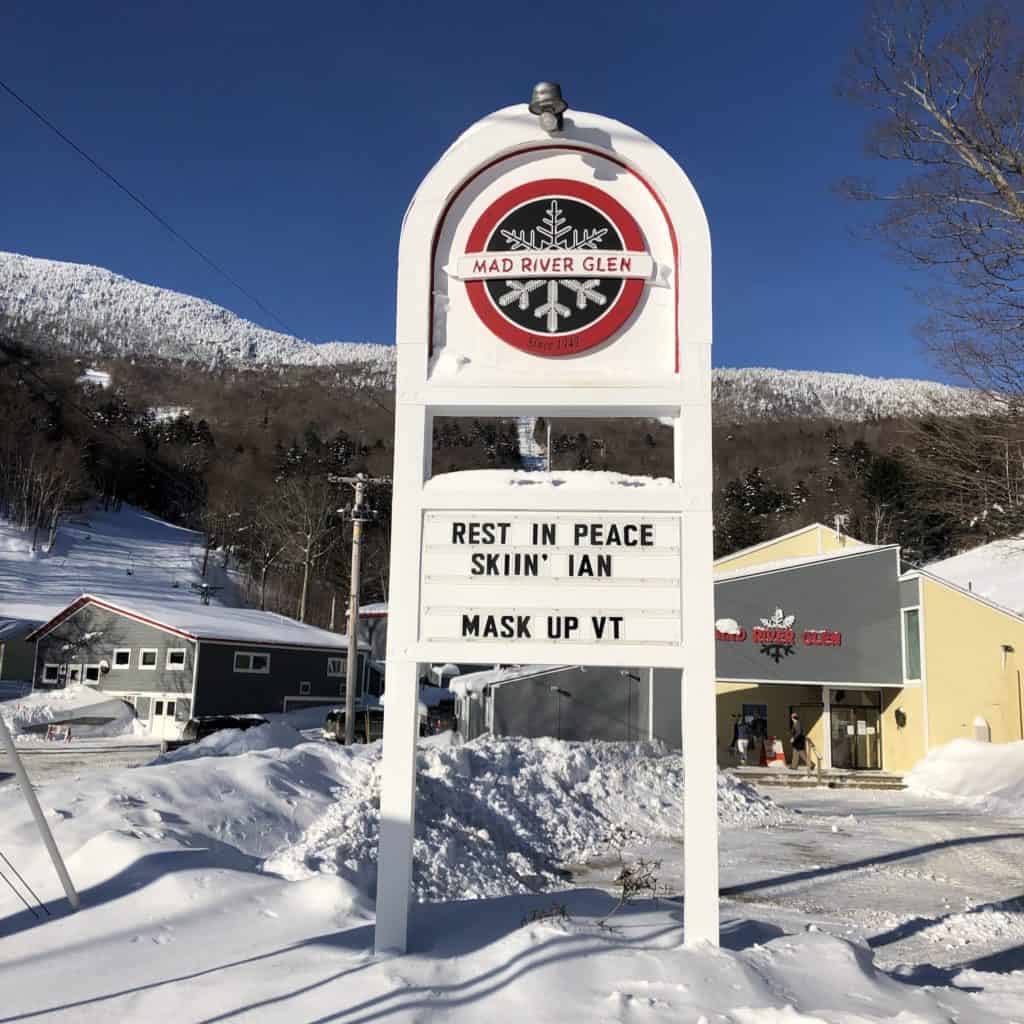
Ian Forgays, an expert skier based in Mad River, was known for finding deep snow in the backcountry. He was killed in an avalanche, Feb. 1.
By Lisa Lynn/VT Ski & Ride
Ian Forgays was a backcountry skier: “Skiin’ Ian” as he was known and, on social media, “Lincoln Lynx.” He wasn’t the type of guy you would see on chairlifts, unless it was the single chair at Mad River Glen where he worked as a liftie, manning the summit station.
You might catch glimpses of him between the trees, a yellow or red jacket charging straight down a drainage off the spine of the Greens, a plume of powder shooting up behind like white smoke.
That white smoke was an elixir.
It was what Forgays, 54, was after when he set out from his home in Lincoln, Vt. for the White Mountains early Monday morning, Feb. 1.
Forgays knew the White Mountains almost as well as he knew the Greens. Born and raised in Vermont, he had hiked the Long Trail three times, skied the Catamount Trail and ridden the Cross Vermont “XVT” bike packing route —300 miles of off-road riding covering the length of the state from Massachusetts to the Canadian border. He made that trip and the Catamount Trail journey in the same year, 2015, completing the “triple crown” of Vermont trails.
Forgays often adventured to the Whites, the Chic Chocs and other high alpine terrain around the Northeast with friends. He was a frequent ski “model” — if you can call the wild-haired guy with a goofy smile and a willingness to charge anything, a model — for Moretown photographers Brian Mohr and Emily Johnson. Their adventures and photos of Forgays made it into Powder and Outside magazines, as well as VT Ski + Ride and Vermont Sports (as pictured right).
The backdrops were the deep untracked woods, the ridgelines and ravines, the abandoned ski areas and snowed-in riverbeds of northern New England.
Ammonoosuc Ravine was one such ravine Forgays loved to ski. On Sunday night, Jan. 31, he texted friends telling them that on Monday he “might ski Monroe Brook depending on how the Ammo looks.”
Heading into Ammo
In the definitive guidebook, “Best Backcountry Skiing in the Northeast,” David Goodman describes Ammonoosuc Ravine, located on the western slope of Mt. Washington as such: “When it is fully covered, Ammo offers one of the longest skiable descents in the White Mountains—nearly 3,000 vertical feet of continuous skiing. The top of the ravine can be a mile-long snowfield that funnels into the Ammonoosuc River…. The Ammo slopes have a sustained 30-degree pitch, getting steeper at the bottom.”
On Monday, Jan. 31, the weather at Mt. Washington was fair and the avalanche danger was rated low. Temperatures ranged from 8-15 degrees F. Winds were unusually light with the highest gusts hitting 25 mph.
The week before, it had been a different story. For three days, winds had been gusting well over 100 mph, hitting a high of 157.
But conditions on Monday looked fine. According to the accident report filed by the Mt. Washington Avalanche Center, they included: “a mix of snow surfaces ranging from ice to rimed snow to firm wind slabs, all of which are commonplace in the wind-raked high alpine areas and steep ravines. Snow surfaces and layers beneath included a widespread, wind-hammered surface created by a wind event the week before. It was dubbed the ‘157 Layer’ after the 157-mph peak wind speed on Jan. 24, which helped create it. Above that layer was another, softer wind slab layer that was described in the forecast as …smooth, hollow-sounding slabs [that] are easy to identify and are generally worth avoiding due to low skiing quality and post-holing on foot if not due to the elevated avalanche risk.”
The snowpack on Monday was not deep. Only 3.4 inches had fallen on the summit between Jan. 23-29, and the Hermit Lake snowplot measured 8 inches. Monday was a calm day before another storm would set in on Tuesday, with heavy snow falling and winds gusting again back over 100 mph at the summit.

A fine day to ski
Forgays got an early start that Monday. He was well equipped, carrying an avalanche transponder, usual safety equipment and a cell phone. By 9 a.m. he had reached treeline on Mount Monroe, and by 11 a.m. he was near the summit of Mount Washington.
From a point above treeline, he texted a photo to Brian Mohr, who was camping in Costa Rica with limited cell phone service. “Miss you bud,” he wrote. Forgays sent a few other photos and texts to friends and then began his descent.
At some point, he triggered a small avalanche.
As the Mt. Washington Avalanche Center incident report stated:
“It is likely that Forgays triggered one of these [wind] pockets and was carried into the bowl-like depression where the snow was stopped by an overhanging cliff that was angled upslope. The debris pile here was deep, but fairly narrow, fanning out from a 10-foot strip to about 25-feet wide by 40-feet long.”
The report continued:
“Finding a triggerable slab in mostly safe avalanche conditions is rare but not unheard of, especially due to our spatially variable, wind slab avalanche problem. Accurately assessing snow and terrain and avoiding trouble throughout a lifetime of playing in the mountains is a tremendous challenge for anyone, even for the most experienced, like Forgays. Most of the time, we survive to ski another day. Other times, simple bad luck catches up to us when our margin for error disappears.”
On Monday, bad luck caught Skiin’ Ian. The small slide into the terrain trap formed by the cliff was enough to bury Forgays. Tuesday’s blizzard sent more snow tumbling down the ravine.
The search
Forgays was well-known in Vermont’s backcountry skiing community and when he didn’t respond to calls on Tuesday, friends began to worry. By Tuesday evening they had alerted New Hampshire Fish & Game that Forgays was missing.
Using cell phone telemetry from cell phone towers in Littleton and Jackson, search and rescue personnel were able to confirm on Tuesday that Forgays was somewhere in the vicinity of Mount Monroe. They began looking for his car in parking lots on both the east and west sides of Mt. Washington. Snow and high winds had filled in on Tuesday, making search conditions difficult and covering any tracks.
The Ammonoosuc Ravine trailhead was unplowed and, with weather moving in, was not checked until Wednesday morning. At 9:45 am, Forgays’ car was discovered. Teams from New Hampshire Fish & Wildlife,
the U.S. Forest Service and Mountain Rescue Services moved into the area.
By analyzing photos and texts that Forgays had sent friends, the search was narrowed to three drainages that feed into the Ammonoosuc River. The accident report stated:
“Open water and thinly bridged stream crossings, combined with elevated avalanche danger, forced teams to travel through dense brush along stream banks. Deep snow created ‘spruce traps,’ hindering rescuers’ travel, even wearing skis and snowshoes.”
Two skiers who were also trained in search and rescue came out of Monroe Brook drainage and confirmed that the snowpack was solid there and that there had been no sign of slides in that drainage. At the same time, cell phone records pinpointed Forgays’ whereabouts to an area directly above the main drainage. As the team moved up the drainage, they saw signs of fresh avalanche debris, most likely from a slide on Tuesday, the day after Forgays went missing.
As the report states:
“At 4:25 p.m., a beacon signal was acquired by a searcher with a dog and Recco receiver in the uppermost flat area beneath the largest continuous WNW-facing slope of the Ammonoosuc, at around 3,950’ of elevation. Pinpoint search techniques with an avalanche transceiver located a beacon signal 3.8 meters (12’6”) beneath the debris, which had piled up against the face of an overhanging rock buttress.”
Eight people took turns over an hour and 35 minutes digging, using the longest probes they had. They finally found Forgays, 13 feet deep, dead from asphyxiation. His was the first avalanche fatality on Mt. Washington in two years. Since 1849, when records began to be kept, only 13 avalanche deaths have been documented on Mt. Washington.

Ian Forgays explores an abandoned bullwheel on Mount Cardigan, New Hampshire, as he skins up the hill.
Living large
“Having spent considerable time in the mountains with Ian over the last 20 years (he loved to ski in front of the camera) we can almost envision how it all went down,” his friend, photographer Brian Mohr wrote to VT Ski&Ride in an email shortly after hearing the news. “He was such a genuine character, a loyal friend, a total goofball, and a hilarious ‘Unky Ian’ to our kids. He was just incredibly stoked to ski. He was truly dedicated to the ski bum lifestyle… and so much more.”
Ry Young, Mad River Glen’s communications director, remembers Forgays’ joy and zest for lift as well. “On nice days, he’d be sitting out in front of the summit shack soaking up the sun like an alligator,” he said. But his best memory is of the first time he met Forgays. “We were mountain biking in Waterbury and kept hearing these whoops and yells. We got closer and this guy goes flying by, shirtless, wearing regular shorts and I am not sure if he even had shoes on. That was Ian.”
Tara Geraghty-Moats, the recent World Cup winner for women’s Nordic Combined and a long-time Mad River Glen skier, posted a moving tribute on Facebook: “Thanks Lincoln Lynx for instilling in everyone around you your love for nature, beer, skiing, racing, duct tape, mirror lenses, flat brims, hard work, Bob Marley, going fast, going way too fast, hucking it, sending it and living it. You were an amazing role model in all the worst and best ways. If there were more people like you in the world, it would be a better place…”
Forgays’ death sent shockwaves through the backcountry community and sympathy was abundant.
On social media, as is often the case, some who did not know him and were not aware of the circumstances were quick to second guess his decisions.
But as the accident report stated:
“Accidents like this serve as a stark reminder to us all of the role that luck can play in successful outcomes in our backcountry endeavors. Ian Forgays had many years of experience in this terrain and, according to texts sent on Sunday, planned ‘to move slowly and intentionally’ knowing that some lines there are ‘rowdier than others.’ By all accounts, he was a very accomplished skier with many of the steepest lines in the Whites under his belt.”

The marquee at Mad River Glen where Forgays worked as a lift operator for decades.
A season of avalanches
Over the past 10 winters, an average of 27 people have died each year in avalanches in the U.S.
This ski season alone, 20 people have died since Dec. 18, 2020. Sixteen of those were skiers or snowboarders in the backcountry, including one former ski patroller and avalanche forecaster in Crested Butte, Colo.
On Feb. 1, the same day Forgays went to Mt. Washington, three experienced skiers from Eagle County, Colorado were swept to their deaths by an avalanche near Silverton.
On Thursday, Feb. 4, in Vail, Colo., a skier ducked out of bounds to the easily-accessed East Vail Chutes when an avalanche buried him in area known as Marvin’s, which is below treeline. Companions and other riders in the area found the skier but were unable to revive him.
And this past Saturday, Feb. 6, four skiers were caught in one of the deadliest slides in Utah’s history, at Millcreek Canyon, prompting Park City Resort to close the backcountry gates.
While avalanche danger may have been far higher in those instances than it was when Ian Forgays set out to ski Ammonoosuc, it is something that is always present to some degree.
As the Mt. Washington incident report concluded:
“In this case, when Ian Forgays triggered a small wind slab, a partner may have saved his life…but given the terrible terrain trap below, maybe not. Forgays was found equipped with avalanche safety gear, including an avalanche transceiver, which helped rescuers and the family immensely. It appears evident from the totality of the circumstances that Forgays was prepared and knowledgeable about the mountain and its ski conditions. But, it is important to remember that even the most experienced skiers with all the correct preparations and equipment risk more when skiing alone. Even small avalanches can be deadly, especially over a terrain trap. If there are lessons to be learned from this accident, they aren’t new. Skiing technical lines, in a thin snowpack above a notorious terrain trap, with no partners, even on a low danger day, raises the stakes tremendously.”
As David Goodman said later when he heard the news: “When we go into the backcountry, we’re motivated by the love of high and wild places. Part of what lures us to the mountains is the drama of these landscapes. But forces much bigger than us are at play when we venture out. ” The Waterbury Center-based author of Best Backcountry Skiing in the Northeast, paused and then added. “It’s very tragic, humbling and sobering to see those forces at work. There but for the grace of God go I.”




